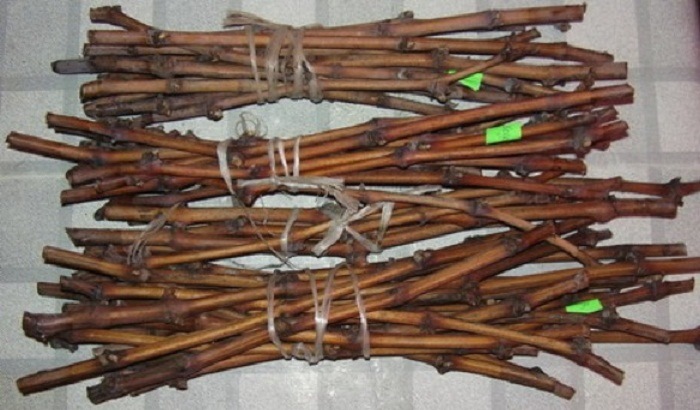 Proper storage of harvested grape cuttings in winter does not actually require any special conditions or significant costs. Accommodation is possible both in a country house and in a city apartment.
Proper storage of harvested grape cuttings in winter does not actually require any special conditions or significant costs. Accommodation is possible both in a country house and in a city apartment.
Such measures will significantly reduce losses that are inevitable when cutting large volumes, cultivating rare, new and demanding plant varieties.
Content
Features of the selection of cuttings
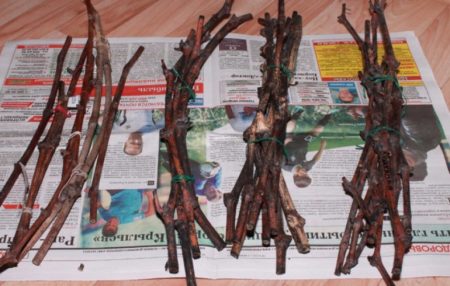 The reproduction of grapes, especially outside the southern regions, often occurs by grafting new crops to those that have already shown their stability and vitality. However, planting in the soil gives good results, but only if you select a quality planting material. Cut branches with a thickness of about 5-8 millimeters and a length of 50 to 70 centimeters are called chubuk. Viability is determined by the number of living and intact kidneys or so-called nodes. There should be 2-4 pieces on each of the seedlings.
The reproduction of grapes, especially outside the southern regions, often occurs by grafting new crops to those that have already shown their stability and vitality. However, planting in the soil gives good results, but only if you select a quality planting material. Cut branches with a thickness of about 5-8 millimeters and a length of 50 to 70 centimeters are called chubuk. Viability is determined by the number of living and intact kidneys or so-called nodes. There should be 2-4 pieces on each of the seedlings.
You can count on excellent survival if the stalk:
- taken from the fruiting vine;
- obtained from a young plant;
- cut off from a ripened vine.
The grapes must be healthy, otherwise you can infect all the plantings in the new area where the planting will take place. In autumn, most large nurseries arrange the sale of cuttings, opening their space to buyers. This is a great opportunity to see with your own eyes the plants, evaluate their maturity and make sure that there are no common diseases.
It is often not possible to check the maturity of the vine with which the chubuk was taken, but at home you can conduct some simple tests. Grease a fresh slice with iodine, wait 3-5 minutes. If the treated area is blackened, then the plant has already reached maturity. When buying, it is more convenient to focus on structure and density. High-quality cuttings when bending produce a noticeable, but light crunch. This suggests that they will be quite easy to save, and in the spring they will be able to take root in a new place.
Autumn harvest
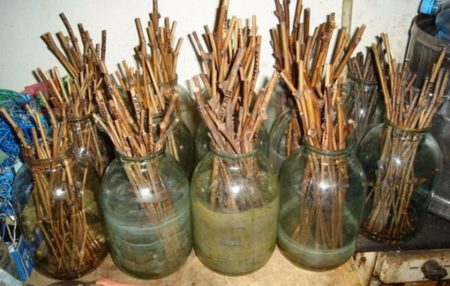 Storage in the winter and germination in the spring will be successful if planting crops are harvested on time and placed in certain conditions. The most common method for producing Chubuk is pruning in the fall after the main fruiting period. This training option has several advantages.
Storage in the winter and germination in the spring will be successful if planting crops are harvested on time and placed in certain conditions. The most common method for producing Chubuk is pruning in the fall after the main fruiting period. This training option has several advantages.
Firstly, storage of grapes in the winter in the shoot allows you to plant it in the spring already in the prepared and well-warmed up soil. Roots may appear immediately, the green part will begin to develop. The sun, heat, moisture will immediately begin to grow, which significantly increases the chance to get a healthy and fruitful plant. If the stalk is cut in the spring, there is very little time for planting on it, it simply cannot be prepared for long-term storage. As a result, the cold earth does not allow the roots to develop; only 30 percent of the plantings survive in these conditions. Secondly, spring pruning is dangerous because it can damage the trunk, in which sap flow has already begun. Chubuki are taken from the bottom of the trunk, here the movement of internal moisture is the most active. Slices in this area can cause illness or even death of grapes.
Harvesting begins in late September or early October. Cuttings are cut with a sharp knife from the fruiting vine as close as possible to the stem or the stiffened part of the plant. Remove all leaves manually without additional cuts. Since in the autumn period the grapes gradually turn into a state of “hibernation”, it absorbs moisture less actively, therefore the Chubuk always requires additional processing before storage.
Storage rules
The winter period is quite long and the main danger for the cuttings is that they can completely dry or freeze. There are some simple rules on how to store grape cuttings, how to prepare them for winter and spring.
Training
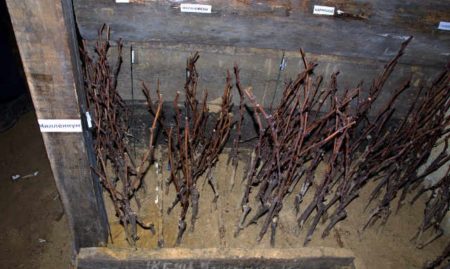 Immediately after cutting, the planting material must be placed in clean water. It should not be boiled, just settled or rain, room temperature. During the day, the plant will gain enough moisture. If the branch was cut with a not too sharp object, you can additionally cut it, this will increase the chances of survival. After a day, the stalk is taken out of the water, the ends are sealed with warm paraffin. This reduces moisture evaporation and prolongs the shelf life.
Immediately after cutting, the planting material must be placed in clean water. It should not be boiled, just settled or rain, room temperature. During the day, the plant will gain enough moisture. If the branch was cut with a not too sharp object, you can additionally cut it, this will increase the chances of survival. After a day, the stalk is taken out of the water, the ends are sealed with warm paraffin. This reduces moisture evaporation and prolongs the shelf life.
If there are doubts about the quality of the "mother" vine, in the absence of diseases, it will require treatment with iron sulfate or potassium permanganate. Seedlings are dipped in solutions with a concentration of 0.5 percent for 3-5 seconds, after which they are thoroughly dried. This allows you to get rid of most of the fungi, bacteria and viruses.
Accommodation in the refrigerator
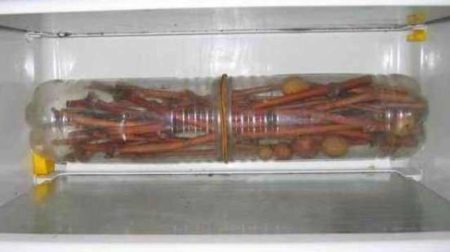 Storage of grape cuttings in the refrigerator is available even to those who do not have separate cellars and cellars, who live in an ordinary city apartment. However, if the amount of planting material is large, difficulties may arise with placement. The refrigerator compartment allows you to maintain optimal conditions, including:
Storage of grape cuttings in the refrigerator is available even to those who do not have separate cellars and cellars, who live in an ordinary city apartment. However, if the amount of planting material is large, difficulties may arise with placement. The refrigerator compartment allows you to maintain optimal conditions, including:
- temperature from +4 to 0 degrees;
- stable humidity of about 60%;
- airing;
- protection from direct sunlight.
In such conditions, even the most frost-sensitive varieties are stored, including dessert and wine grapes. Place the cuttings in the compartment for vegetables and fruits or on the lower shelf of the chamber. If the refrigerator is used for its intended purpose, and not just as a storage of chubuk, it is necessary to wrap the seedlings in a slightly damp cloth, wrap the bag, but not completely, to avoid decay. The harvested cuttings are checked monthly.
Cellar storage
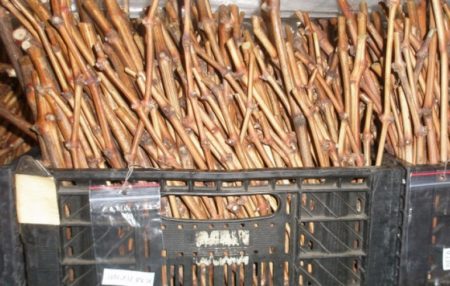 Basement or cellar should be sufficiently dry, protected from freezing. If vegetables are stored in such rooms and they do not freeze even in the most severe winters, then the conditions will be suitable for Chubuk. But it is important to remember that regular ventilation is required.
Basement or cellar should be sufficiently dry, protected from freezing. If vegetables are stored in such rooms and they do not freeze even in the most severe winters, then the conditions will be suitable for Chubuk. But it is important to remember that regular ventilation is required.
Widespread vertical placement of Chubuk. Sand is poured into a shallow container with a layer of up to 10 centimeters, slightly moistened with water at room temperature. Cuttings are stuck into the base in accordance with their natural position, and not in an inverted state. Seedlings should not touch each other. The preservation of grapes in the winter in the cellar should be checked, which is easy to do by inspecting the upper open part of the chubuk. Monthly moisturize capacity.
The second storage option is horizontal. Cuttings are stacked in a container in layers, alternating seedlings with a filler in the form of sand or moss. Periodically, the entire container should be moistened, it is possible to increase the time of evaporation of moisture by covering the container with polyethylene.In this case, the cuttings should be especially carefully examined for mold and rot. Twice during the winter, you need to swap the upper and lower bookmarks.
How to use trenches
If it is not possible to use a refrigerator or a cellar, you can place the cuttings in an ordinary trench. Dig it up on a dais. The depth should be at least half a meter, and the width is calculated based on the size of the largest seedling. A margin of at least 5 centimeters on each side is required. The walls of the trench are treated with ordinary lime, sand is poured on the bottom with a layer of 10 centimeters. Chubuki is installed vertically or laid horizontally, alternating also with sand. The top layer is soil. It is advisable that the finished "storage" slightly protrude above the general level of the site. It is possible to store grape cuttings until spring with this method only if there are no too strong and prolonged frosts in the region. In addition, spills, flooding and the most common rodents will threaten planting material.
Storage of purchased Chubuk
When buying in a specialized nursery, you can get already fully prepared cuttings, they will only have to be placed. However, if plants are purchased from private breeders, acquaintances and local lovers, special attention must be paid to the treatment of diseases. It is recommended to place separately Chubuki harvested in their own vineyard, and those copies that were purchased additionally.
Spring check
Before planting, it is important to inspect all the seedlings. Ready for further growth will have an elastic and rigid structure, and not sluggish and soft. Under the thin bark, a green living layer remains. It is necessary to store grape cuttings in winter for a long time, but despite this, strong plants can give the first leaves a couple of days after immersion in water in a warm room. Using this method, you can check a couple of seedlings, determining the quality of the entire batch. Planting sprouted at home Chubuk is also acceptable.
Strong cuttings already in the process of storage can develop the kidneys on them. They literally "pour" in a couple of days after the planting material is removed from the refrigerator or the cellar. Such chubuki do not require any further awakening and are fully prepared for landing.
Proper storage of grape cuttings during the long winter is not a difficult task. Seedlings can be placed in the refrigerator, and in the cellar, and even in ordinary trenches. However, the thermophilic culture does not tolerate frost and too high humidity, therefore, monitoring of these parameters is mandatory. Propagation of grapes by cuttings is the fastest way to get a fruiting vine or to vaccinate a new variety, so storage of seedlings in the fall should be mastered.

 Non-covering winter-hardy grape varieties for Moscow region
Non-covering winter-hardy grape varieties for Moscow region How to keep the vine in winter
How to keep the vine in winter When can I transfer grapes to another place in the fall
When can I transfer grapes to another place in the fall How to cover and prepare grapes for the winter in the suburbs
How to cover and prepare grapes for the winter in the suburbs